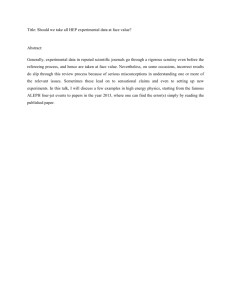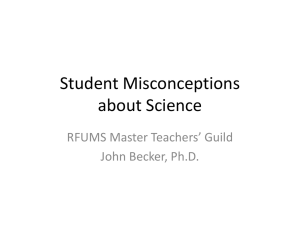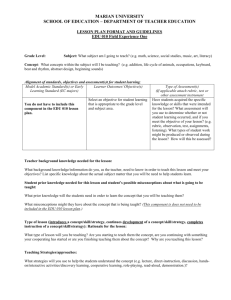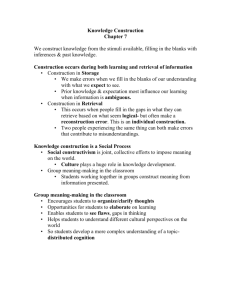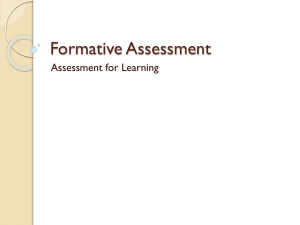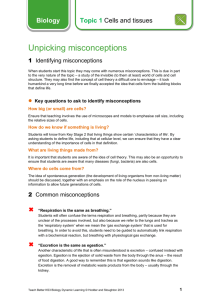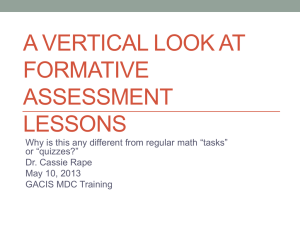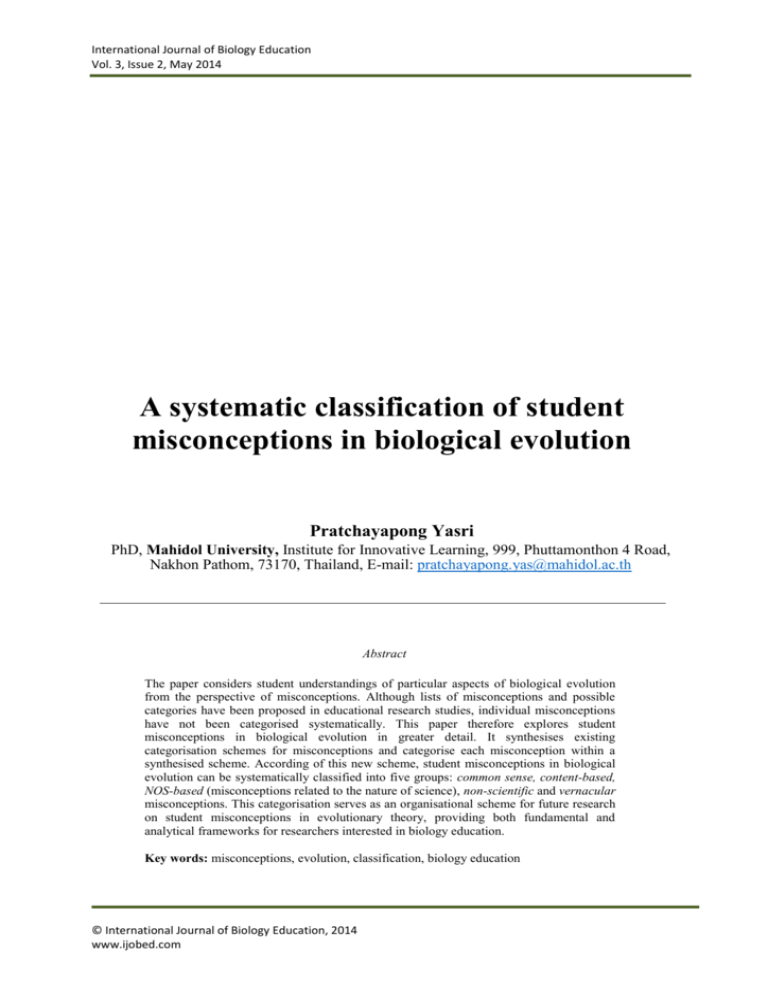
International Journal of Biology Education
Vol. 3, Issue 2, May 2014
A systematic classification of student
misconceptions in biological evolution
Pratchayapong Yasri
PhD, Mahidol University, Institute for Innovative Learning, 999, Phuttamonthon 4 Road,
Nakhon Pathom, 73170, Thailand, E-mail: pratchayapong.yas@mahidol.ac.th
Abstract
The paper considers student understandings of particular aspects of biological evolution
from the perspective of misconceptions. Although lists of misconceptions and possible
categories have been proposed in educational research studies, individual misconceptions
have not been categorised systematically. This paper therefore explores student
misconceptions in biological evolution in greater detail. It synthesises existing
categorisation schemes for misconceptions and categorise each misconception within a
synthesised scheme. According of this new scheme, student misconceptions in biological
evolution can be systematically classified into five groups: common sense, content-based,
NOS-based (misconceptions related to the nature of science), non-scientific and vernacular
misconceptions. This categorisation serves as an organisational scheme for future research
on student misconceptions in evolutionary theory, providing both fundamental and
analytical frameworks for researchers interested in biology education.
Key words: misconceptions, evolution, classification, biology education
© International Journal of Biology Education, 2014
www.ijobed.com
Misconception in evolution
Fundamental scientific concepts of biological evolution
This section reviews fundamental concepts of biological evolution as explained by scientists
and science educators. The review aims to present a standard understanding of the theory of
biological evolution which is later used to compare with student misconceptions in biological
evolution. To begin with the definition of evolution, Scott (2004, p. 23) defines the term
evolution broadly as “a cumulative change through time”, pointing out that there are various
meanings of evolution including astronomical, geological, chemical and biological evolution.
However, in this paper, the term evolution is limited only to the strand of biological evolution.
Wiles (2010, p. 18) defines this as the explanation for “the diversity of life on Earth [which]
has arisen via descent with modification from a common ancestry” (p. 18). Scott (2004, p. 27)
specifically explains that biological evolution is not the explanation of the origin of life itself
but “the descent of living things from ancestors from which they differ” (p. 27). Taking her
broad and specific definitions together, Scott (2004, p. 27) comments that “descent with
modification through time” is an effective explanation of biological evolution.
Instead of focusing on defining the term evolution, Alexander (2009) distinguishes
between three main aspects of biological evolution: evolutionary devices (i.e. DNA and genes),
evolutionary mechanisms (i.e. natural selection and reproductive success) and the result of their
combination in the form of macroevolution (i.e. speciation and fossils). These aspects are
relevant to five core aspects of biological evolution guided by Biological Sciences Curriculum
Study (2005) which are suggested as important to introduce to high school students in the US,
consisting of how species evolve over periods of time, how species evolve from common
ancestors, how new forms of species derive from existing species (speciation), how
evolutionary processes gradually occur, and how natural selection plays a major role in the
evolutionary mechanism. Indeed, these are aspects originally contributed by Charles Darwin
(1859) and elaborated in his book entitled the Origin of Species by Means of Natural Selection,
but which have been developed through the advanced knowledge of genetics and molecular
biology (Jablonka & Lamb, 2014).
As a consequence of Darwin’s book, the term natural selection has been widely used.
Among biological scientists, this process is generally “considered to be the most powerful
source of evolutionary change” (Scott, 2004, p. 34). Pongsophon (2006) points out that high
school students in Thailand are required to understand five sequential steps of the mechanism
of natural selection: the origin of genetic variation (alterations of genetic information of
inherited traits within a population), the role of genetic variation (unpredictable outcomes
which can lead to either beneficial, neutral or harmful traits depending on certain environmental
conditions), change in a population trait (those having traits that are beneficial in a particular
environment achieve higher reproductive rates and become dominant), the role of environment
(environmental conditions as selective agents), and speciation (the emergence of distinct
species resulting from the accumulation of genetically isolated populations of a single species
over time).
Apart from the in-depth consideration of what biological evolution means and is about,
Smith (2010) suggests that it is also important for students to understand what evolution is not;
and thus he points out three essential points. First, evolution is not a discipline of faith. In other
words, the science of evolution focuses on the natural world and questions relating to
32
International Journal of Biology Education
Vol. 3, Issue 2, May 2014
supernatural powers are beyond its scope. Second, like Scott (2004), Smith (2010) argues that
biological evolution explains the origin of species from ancestral species, not the origin of the
first living organisms. In other words, there are scientific distinctions between the theory that
explains the origin of life (abiogenesis) and the theory that explains the origin of biodiversity
of life forms (biological evolution). Third, biological evolution is emergent, not directional.
Therefore, teleological thinking which concerns purposes of evolutionary events is not an
aspect of consideration based on scientific perspectives. In addition, Smith (2010) provides an
extensive list of common misconceptions derived from a review of the existing literature. This
list forms the basis for the study described in this paper, and is discussed in the next section.
Misconceptions in science
Eggen and Kauchak (2004) explain that concepts can be considered as ideas that help us make
sense or understand the world around us. Thus misconceptions are preconceived notions that
provide some sorts of understanding but that are not in line with justified knowledge (Martin et
al., 2002). Thompson and Logue (2006) note that there are possible ways for learners to develop
misconceptions such as through parents (e.g. they might be confronted with questions from
their children, and rather than admitting that they are unable to answer, they might give an
incorrect answer), through media (e.g. learners may consult online sources of information that
they perceive as “trustworthy” but they may not provide correct information), or through
teachers (e.g. learners may perceive teachers as their cognitive authority and fully accept what
they explain or believe as correct information), among others.
Using the language of misconceptions might be considered as a “bad” way of describing
student conceptions through the implication that these are “wrong”, which is relatively negative
and may appear judgmental. However, judging student understandings as “right” and “wrong”
may not be helpful in any ways (Hokayem & BouJaoude, 2008). Therefore, the working
definition of misconceptions in science used throughout this paper is limited to alternative
frameworks or ideas about the world perceived by learners that are different from the accepted
scientific ideas (Allen, 2010). Thus misconceptions are simply those ideas that contrast with
accepted scientific accounts (whether or not these are factually “correct”).
In order for biology teachers to help their students develop a scientific understanding of
biological evolution, it is important to identify which ideas about evolution constitute
misconceptions (Committee on Undergraduate Science Education National Research Council,
1997). Smith (2010) highlights a series of misconceptions in biological evolution and the nature
of science related to the theory of evolution reported in empirical studies. He presents them in
five themes: those generated from personal experiences (e.g. genetic mutations are always
detrimental to fitness such as those that cause cancers and physiological malfunctions), those
constructed by learners based on different stages of their conceptual development of scientific
reasoning (e.g. teleological thinking that evolution is function and/or purpose directed), those
caused by poor science education (e.g. Lamarckian misconceptions and misunderstanding of
the nature of science), those arising from misuse of everyday spoken terms (e.g. theory versus
law), those related to religious claims (e.g. young earth creationist beliefs).
Mapping Smith (2010)’s themes of misconceptions about biological evolution onto a
33
Misconception in evolution
standard classification of misconceptions about science proposed by the Committee on
Undergraduate Science Education National Research Council (1997), a similarity is found. The
Committee on Undergraduate Science Education National Research Council (1997) classify
misconceptions about science into five groups: preconceived notions, non-scientific beliefs,
vernacular misconceptions, conceptual misconceptions and factual misconceptions. Although
this classification is used to explain misconceptions in science in general (no examples of
biological evolution are given in the original text), it can be applied to the theory of evolution
and the misconceptions compiled by Smith (2010) appropriately.
A synthesised classification of misconceptions in biology education
This section proposes a systematic classification of misconceptions about biological evolution
based on the categorical schemes discussed by the Committee on Undergraduate Science
Education National Research Council (1997) and Smith (2010). The need for this is that no
classification of misconceptions of biological evolution has been provided in the literature.
Although Smith (2010) proposes the five themes of misconceptions (from experience
misconceptions, self-constructed misconceptions, taught-and-learned misconceptions,
vernacular misconceptions, and religious misconceptions), he does not explicitly and
systematically classify the misconceptions themselves, and does not discuss in the main text in
his paper how these themes arose. They are only shown in the summary table where the
misconceptions are presented (pp. 552-553), and grouping might be for the purpose of
readability. Having noted that, Smith (2010)’s themes are considered as a very good starting
point. Therefore, based on his work and the classification of misconceptions in science in
general by the Committee on Undergraduate Science Education National Research Council
(1997), a systematic classification of misconceptions about biological evolution and the nature
of science related to the theory of evolution is proposed here (see Table 1). Justifications for
reorganisation of the two schemes for grouping misconceptions are discussed in the following
paragraphs. Selected terminologies to define each group of the proposed classification are also
introduced.
Table 1. Classifications of misconceptions about biological evolution
Smith (2012b)
From-experience misc.
Self-constructed misc.
Vernacular misc.
Religious misc.
Taught-and-learned misc.
(group 1)
Taught-and-learned misc.
(group 2)
Committee on Undergraduate
Science Education National
Research Council (1997)
A proposed
categorisation for
future use
Preconceived notions
Common sense misc.
Vernacular misc.
Non-scientific beliefs
Conceptual misc.
Factual misc.
Vernacular misc.
Non-scientific misc.
-
NOS-based misc.
34
Content-based misc.
International Journal of Biology Education
Vol. 3, Issue 2, May 2014
First, two themes presented by Smith (2010) including from experience misconceptions
and self-constructed misconceptions are well captured by the definition of preconceived notions
presented by the Committee on Undergraduate Science Education National Research Council
(1997). These all seem to refer to ideas constructed by individuals’ common sense based on
daily life activities. Although minor variations in definitions can be further discussed, these
previously proposed themes seem to have a common ground in terms of the use of personal
experiences to construct one’s own knowledge of a given phenomenon. In this paper, it is
therefore considered as more sensible to combine them together and they are now called
common sense misconceptions.
Second, whereas the Committee on Undergraduate Science Education National
Research Council (1997) differentiate conceptual misconceptions from factual misconceptions,
Smith (2010) combines them in the theme of taught-and-learned misconceptions. However, in
order to frame the discussion on the ground of its simplicity, the latter work is preferably chosen
in this study. This is due to the fact that conceptual misconceptions and factual misconceptions,
at least in the context of biological evolution are unlikely to be completely separate. It is likely
that the main difference between conceptual and factual misconceptions is the “seriousness” of
misunderstanding. Conceptual misconceptions are recognised by the Committee on
Undergraduate Science Education National Research Council (1997) as preconceptions about
particular theories that have never been replaced by accurate scientific explanations. In contrast,
factual misconceptions are falsities held by learners which remain unchanged through time.
In order to elaborate this distinction in the light of biological evolution, two obvious
examples are given. While Lamarckian ideas of evolution constitute conceptual
misconceptions, belief that man evolved from monkeys or modern apes associates with factual
misconception. Although scientifically invalid, the former relatively seems to be more
sophisticated, whereas the latter is considered to be relatively simplistic. However, the
distinction between these kinds of misconceptions is unclear and in fact problematic. For
example, one is obliged to determine which conceptions are “simplistic” versus “sophisticated”,
or to decide whether conceptions might change over time or not. These appear ill-defined.
Therefore, it is argued in this paper that these two groups should be combined into one, and the
new group shall be called content-based misconceptions.
Finally, Smith (2010) conflates misconceptions related to contents of biological
evolution with misconceptions related to the nature of science associated with evolution in his
taught-and-learned misconceptions, although he himself explicitly notes in the summary table
which misconceptions are considered to be particularly related to the nature of science. In
science education research, these two types of misconceptions are often studied separately. This
paper therefore argues that content-based misconceptions and misconceptions related to the
nature of science are distinct. The term adopted here for the latter is NOS-based misconception,
where NOS stands for nature of science. This abbreviation will be use throughout this paper
from this point onwards.
Student misconceptions in biological evolution
In this section, student misconceptions in biological evolution and the nature of science related
35
Misconception in evolution
to the theory of evolution will be reviewed according to the proposed classification discussed
in Section 3. Examples used in the discussion below are drawn from a number of papers
addressing student misconceptions in biological evolution. The aim of this is primarily to
provide the theoretical framework of future development of the body of research in student
misconceptions about biological evolution.
Common sense misconceptions
Common sense misconceptions are ideas that arise from experiences in daily life activities,
according to the Committee on Undergraduate Science Education National Research Council
(1997). Learners appear to link their experiences with natural phenomena and construct their
own understanding about them based on personal rationalisation. For example, many learners
think that evolution usually occurs in a purposeful direction starting from lower taxonomical
species towards higher ones (Alter and Nelson, 2002, Smith, 2010, González Galli and
Meinardi, 2011). González Galli and Meinardi (2011, p. 147) refer to these ideas as “common
sense teleology”, explained as the misuse of science to explain that something exists for a
particular purpose based on non-scientific ways of thinking.
Another misconception based on common sense is an argument from design. According
to this argument, the orderliness apparent in the biological world, commonly referred to as the
“design”, such as biochemical pathways in living cells, structural units of biochemical
molecules, the complexity of organ systems, and physiological functions of living organisms,
provides evidence for the existence of an intelligent designer (Fuller, 2007). A classic example
of this argument is taken from William Paley who compares the complexity of living things to
the complexity of a watch, which is known to be designed. The teleological argument
specifically made for this analogy is that just as a watch could not exist without a watchmaker,
living things could not exist without an intelligent designer (Finlay, 2004). However, this
argument is opposed by scientists because the complexity of the biological world can be
explained through random mutation and natural selection according to Neo-Darwinian
evolution (Alexander, 2009). González Galli and Meinardi (2011, p. 147) argue that designrelated misconceptions are an obstacle to evolution learning.
Content-based misconceptions
In this study, content-based misconceptions are any ideas perceived by individuals that
contradict the fundamental concepts of biological evolution described in Table 2. Three main
content-based misconceptions are predominantly discussed in the literature composing of the
theory of acquired inheritance, known as Lamarckian inheritance (Pongsophon, 2006), the topic
of the origin of living cells according to the theory of abiogenesis (Rice et al., 2010), and human
evolution.
Focusing on Lamarckian inheritance, Pongsophon (2006) explains that many students
believe that changes in individual organisms are made by the organisms themselves and they
can pass these characteristics on to their offspring. However, Gregory (2009, p. 169) explains
that physical changes that occur during an organism’s lifetime cannot be passed on to offspring.
This is because the cells that are involved in reproduction (the germ line) are distinct from those
that make up the rest of the body (the somatic line); only changes that affect the germ line can
be passed on.
36
International Journal of Biology Education
Vol. 3, Issue 2, May 2014
Building from this misconception, many form the idea that evolution is a needs-based
process and that animals have to evolve in order to survive. For them, evolution is understood
to occur in a linear direction starting from the less adaptive species towards the more adaptive
ones (Alter and Nelson, 2002, Smith, 2010, González Galli and Meinardi, 2011). However, the
current knowledge from population genetics explains that the perceived direction of evolution
is the consequence of the reproductive success (or fitness) of populations, not physical
adaptation through a need-based process of individual organisms (Stearns and Hoekstra, 2005).
In small populations, drift is also an important factor determining evolutionary outcomes.
Another example of content-based misconceptions is related to the confusion between
abiogenesis and biological evolution (Smith, 2010). When considering the term biological
evolution, many appear to view it holistically as the biological history of life, starting from the
origin of the first molecules of life and the first living cell, the development of multicellular
organisms, to the emergence of higher taxonomical animals and human beings. In fact,
scientific explanations differentiate between the processes by which life arose from non-living
matter and those by which life developed into the diverse forms recognised today: the former
processes are those of abiogenesis; the latter are explained by evolutionary theory (Rice et al.,
2010). Smith (2010, p. 542) notes that “in the strictest sense, Darwinian evolution is an
explanation of the origin of species from ancestral species, not the origin of the first living
thing” (p. 542).
A few more examples of content-based misconceptions related to human evolution are
found in empirical studies with students. Clores and Limjap (2006) report that one of their
student participants believed that humans evolved from monkeys. This is also the case in Yasri
and Mancy (2014)’s study. This looks like a fairly obvious sign of misconceptions about human
evolution (Stringer, 2012). To be more scientifically accurate, humans share a common
ancestor with modern apes, like gorillas and chimpanzees. Nonetheless, it is possible that the
learners involved in these studies failed to distinguish between monkeys and other apes
(including our shared proto-ape ancestor with other modern apes), in which case the
misunderstanding is in taxonomic vocabulary as opposed to evolutionary processes. Finally,
Nehm and Schonfeld (2007) report that their participants believed that evolutionary theory
demonstrates coexistence between humans and dinosaurs. However, Pickrell (2006) responds
sarcastically to this view that “dinosaurs and people coexist only in books, movies and cartoons.
The last dinosaurs - other than birds - died out dramatically about 65 million years ago, while
the fossils of our earliest human ancestors are only about 6 million years old”.
NOS-based misconceptions
Turning to misconceptions in biological evolution with regard to the nature of science, as the
Biological Sciences Curriculum Study (2005) argues, scientific theories should not be studied
in isolation from the ways in which the theories have been developed. Therefore, the nature of
science becomes an important area of science instruction of concern to science educators (AbdEl-Khalick, 2012, Dagher and BouJaoude, 2005). Alongside the mainstream of research in the
generic domain of the nature of science, student perceptions of the nature of evolutionary theory
in particular have been investigated.
For example, Dagher and BouJaoude (2005) propose different aspects of the nature of
37
Misconception in evolution
science related to biological evolution that college biology students tend to misunderstand.
First, the students sometimes considered that no “solid” evidence to validate the theory of
evolution. Second, they sometimes wrongly perceived the certainty of the theory of evolution
by expressing two radical views towards the degree of certainty. Some viewed that the theory
of evolution is unchanging, whereas others considered that it remains uncertain and will be
changed. Third, some students believed that no experimental investigations can directly test
macroevolution and that experiments are required for science. Fourth, they consider that the
development of the theory of evolution is ambiguous as some steps of the scientific method are
missing; however, no explanation is given by the students which steps these are.
Non-scientific misconceptions
Non-scientific misconceptions refer to different views perceived by individual learners based
on external sources other than science. Smith (2010) specifically points out that the major form
of this kind of misconceptions is associated with religious beliefs. In relation to the theory of
evolution, Scott (2004) classifies a range of positions in which religious beliefs are used to
explain the scientific knowledge of the origin of life and biodiversity such as flat eartherism,
geocentrism, young earth creationism, gap creationism, day-age creationism and progressive
creationism. More broadly, a range of views for relating scientific and religious perspectives
are identified both from philosophical (Yasri et al., 2013) and empirical perspectives (Yasri &
Mancy, 2014).
While many authors argue that these creationist/religious perspectives are
misconceptions (e.g. Pongsophon, 2006, Scott, 2004, Williams, 2009), Reiss (2009a) asserts
that teachers should think of these as student worldviews rather than mere misconceptions.
Taking the assertion of Reiss (2009a), it is argued in this paper that religious beliefs have their
own values and should not be judged as either right or wrong, especially not “en masse” in the
sense of constituting misconceptions. However, it is undeniable that there are different sets of
religious beliefs that obviously contradict scientific discoveries (Yasri et al. 2013; Yasri &
Mancy, 2014) and thus it is possible to consider these beliefs as misconceptions, at least from
a scientific point of view. For example, the young-earth creationist claim that the world is only
about 6000-10000 years old, has been shown to be factually incorrect by strong and coherent
evidence in the geological sciences. However, to be explicit that there is no intention to make
claims against religious beliefs in general in this study, the term used to describe this group of
misconceptions is non-scientific misconceptions.
To elaborate a little, misconceptions can be understood as alternative ideas that may not
be ontologically false, but for which there is no evidence (Allen, 2010). For example, to claim
that the world is designed might be true, but science cannot show that to be the case. Also, and
perhaps more subtly, the claim that biological complexities are the results of intelligent design
might be a true statement, but these complexities can be explained by science without recourse
to the notion of a designer (Fuller, 2007). Thus repeating itself again, misconceptions as
considered in this paper are “scientific misconceptions” and include alternative ideas that
cannot or have not been demonstrated scientifically, that go beyond scientific claims.
Vernacular misconceptions
According to the Committee on Undergraduate Science Education National Research Council
38
International Journal of Biology Education
Vol. 3, Issue 2, May 2014
(1997), vernacular misconceptions stem from the use of particular words that are understood
differently between everyday life and scientific expressions. In other words, there are a number
of terms that are used differently between members of the public and members of the scientific
community. For example, Scott (2005) argues that, in everyday use, a “theory” means a guess.
In science, a theory is not a guess, but “a logical construct of facts and hypotheses that attempts
to explain a natural phenomenon” (p. 241). Therefore, saying that “evolution is just a theory”
is a vernacular misconception used to reject evolution on the ground of disbelief rather than
logical arguments.
Another example is given by Mead and Scott (2010) in relation to the use of terms
chance and randomness. Among the scientific community, both are used in the fashion of
statistical explanations. In science, the chance that something will happen means that it will
occur according to a known probability. For example, the chance of having a child who has a
type O blood from a mother having AO and a father BO alleles is one in four. Randomness is
normally used in the sense of being governed by equal probability. For example, within a
population mating system, every female gamete might be assumed to have an equal opportunity
of being fertilised by every male gamete.
In contrast, the general public and students may interpret these terms differently. Mead
and Scott (2010) explain that both of the terms are used non-probabilistically among students.
Generally, Mead and Scott (2010) argue that many students misuse the terms by conflating
random with purposelessness and chance with directionlessness. Often, those rejecting
evolution rely on these vernacular misconceptions to spread their objections to evolution. For
example, they contrast the terms chance and randomness with design in nature (i.e. Paley’s
analogy of the watchmaker). In this paper, although it is acknowledged that students may
understand the terms scientifically, it is assumed that Mead and Scott (2010) may be right that,
in general, students use them non-scientifically and towards rejection of evolution.
Summary
Based on the existing literature on biology education, this paper presents that student
misconceptions in biological evolution can be systematically classified into five groups:
common sense misconceptions, content-based misconceptions, misconceptions related to the
nature of science, non-scientific misconceptions and vernacular misconceptions. The
categorisation serves as an organisational scheme for future researchers in the filed biology
education. It allows researchers to analyse and interpret findings on patterns of student
misconceptions more easily and systematically. However, it is acknowledged that finding a
categorisation structure and classify individual misconceptions in a way that is entirely
objective or clear-cut is difficult. This paper also calls for empirical uses of this scheme in
biology education research in order to validate its generalizability and usefulness. In addition,
constructive modifications for future developing this scheme are encouraged to advance current
understanding on student misconceptions in biological evolution.
References
Abd-El-Khalick, F. (2012). Examining the Sources for our Understandings about Science: Enduring conflations
and critical issues in research on nature of science in science education. International Journal of
Science Education, 34, 353-374.
39
Misconception in evolution
Allen, M. (2010). Misconceptions in primary science. Berkshire, Open University Press.
Alexander, D. (2009). Creation or evolution: Do we have to choose?, Oxford, Monarch Books.
Alter, B. J. & Nelson, C. E. (2002). Perspective: teaching evolution in higher education. Evolution, 56, 18911901.
Biological Sciences Curriculum Study (2005). The nature of science and the study of biological evolution,
Washington DC, NSTA Press.
Clores, M. & Limjap, A. (2006). Diversity of students' beliefs about biological evolution. Asia Pacific Journal of
Education, 26, 65-77.
Committee on Undergraduate Science Education National Research Council (1997). Science Teaching
Reconsidered: A Handbook, Washington DC, The National Academies Press.
Dagher, Z. R. & Boujaoude, S. (2005). Students' perceptions of the nature of evolutionary theory. Science
Education, 89, 378-391.
Darwin, C. (1859). On the Origin of Species, London, John Murray.
Eggen, P. & Kauchak, D. (2004). Educational Psychology: Windows, Classrooms, Upper Saddle River, Pearson
Prentice Hall.
Finlay, G. (2004). Evolving creation. Auckland, TELOS Books.
Fuller, S. (2007). Science vs Religion? Intelligent design and the problem of evolution. Cambridge, Polity Press.
González Galli, L. & Meinardi, E. (2011). The Role of Teleological Thinking in Learning the Darwinian Model
of Evolution. Evolution: Education and Outreach, 4, 145-152.
Gregory, T. (2009). Understanding Natural Selection: Essential Concepts and Common Misconceptions.
Evolution: Education and Outreach, 2, 156-175.
Hokayem, H., & BouJaoude, S. (2008). College students' perceptions of the theory of evolution. Journal of
Research in Science Teaching, 45(4), 395–419.
Jablonka, E., & Lamb, M. J. (2014). Evolution in Four Dimensions, revised edition: Genetic, Epigenetic,
Behavioral, and Symbolic Variation in the History of Life. MIT press.
Mead, L. & Scott, E. (2010). Problem Concepts in Evolution Part I: Purpose and Design. Evolution: Education
and Outreach, 3, 78-81.
Nehm, R. H. & Schonfeld, I. (2007). Does increasing biology teacher knowledge about evolution and the nature
of science lead to greater advocacy for teaching evolution in schools? Journal of Science Teacher
Education, 18, 699-723.
Pickrell, J. (2006). Top 10: Dinosaur Myths. NewScientist.
Pongsophon, P. (2006). Enhancing Thai students' scientific understanding of evolution: A social constructivist
approach. PhD Thesis, Kasetsart University.
Reiss, M. J. (2009). The relationship between evolutionary biology and religion. Evolution, 63, 1934-1941.
Rice, J. W., Warner, D. A., Kelly, C. D., Clough, M. P. & Colbert, J. T. (2010). The theory of evolution is not an
explanation for the origin of life. Evolution: Education and Outreach, 3, 141-142.
Scott, E. C. (2004). Evolution vs Creationism: An Introduction, California, University of California Press.
Smith, M. (2010). Current Status of Research in Teaching and Learning Evolution: II. Pedagogical Issues.
Science & Education, 19, 539-571.
Stearns, S. C. & Hoekstra, R. F. (2005). Evolution, Oxford, Oxford University Press.
Stringer, C. (2012). Evolution: What makes a modern human. Nature, 485(7396), 33-35.
Thompson, F. & Logue, S. (2006). An exploration of common student misconceptions in science. International
Education Journal, 7, 553-559.
Wiles, J. (2010). Overwhelming scientific confidence in evolution and its centrality in science education and the
public disconnect. Science Education Review, 9, 18-27.
Williams, J. D. (2009). Belief versus acceptance: why do people not believe in evolution? Bioessays, 31, 12551262.
Yasri, P. & Mancy, R. (2014). Understanding student approaches to learning evolution in the context of their
perceptions of the relationship between science and religion. International Journal of Science
Education, 36(1), 24-45
Yasri, P., Arthur, S., Smith, M. U. & Mancy, R. (2013). Relating science and religion: An ontology of taxonomies
and development of a research tool for identifying individual views. Science & Education, 22, 2679–2707.
40
International Journal of Biology Education
Vol. 3, Issue 2, May 2014
Appendix
Table 1. Summary of misconceptions and scientifically fundamental concepts of biological
evolution and the nature of science related to evolution.
Groups
Common
sense
Contentbased
Misconceptions
Biological complexities are the results
of intelligent design.
Evolution explains changes in
individual organisms.
Evolution explains the adaptation of
organisms caused by environmental
changes in which useful characteristics
of organisms are passed on.
Evolution explains the origin of life, the
first living things or the origin of
species from non-living particles.
Evolution explains linear development
of humans from monkeys.
Evolution is not testable in the
laboratory.
Evolution contains lacks valid support.
Evolution contradicts religious belief.
Evolutionary theory is based on
NOSspeculation.
based
Macroevolution cannot be observed in
the laboratory.
Scientists doubt if evolution occurs.
Science undermines religion.
Science is unchanging.
Science involves truth and certainty.
Science is totally objective.
Species existing today were created in
Nonsix 24-hour days or between 6000scientific
10000 years
Biological complexities are the result of
chance and randomness.
Vernacular
Evolution is a purposeless process or a
directionless process.
41
Scientifically fundamental concepts
Biological complexities are the results of
evolutionary processes.
Evolution explains changes in populations
of individual organisms.
Biological evolution can be described as
arising from differential reproductive rates
due to different reproductive success among
a population of organisms.
Biological evolution is the explanation of
the origin of species from pre-existing
species by means of natural selection.
Biological evolution explains the origin of
species from ancestral species.
Evolution is testable in the laboratory.
Forms of evidence support evolution
Evolutionary theory does not undermine
faith.
Evolutionary theory is based on research.
Evolutionary theory is developed from
factual and historical data.
Scientists fully accept evolution.
Science is limited to the natural world.
Science develops through time.
Science is tentative.
Science is based on human endeavour.
Species existing today have gradually
developed from their early forms over
millions of years.
Biological complexities are the results of
natural section.
Evolution is a dynamic process.


